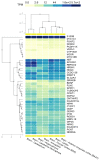The Polygenic Nature and Complex Genetic Architecture of Specific Learning Disorder
- PMID: 34068951
- PMCID: PMC8156942
- DOI: 10.3390/brainsci11050631
The Polygenic Nature and Complex Genetic Architecture of Specific Learning Disorder
Abstract
Specific Learning Disorder (SLD) is a multifactorial, neurodevelopmental disorder which may involve persistent difficulties in reading (dyslexia), written expression and/or mathematics. Dyslexia is characterized by difficulties with speed and accuracy of word reading, deficient decoding abilities, and poor spelling. Several studies from different, but complementary, scientific disciplines have investigated possible causal/risk factors for SLD. Biological, neurological, hereditary, cognitive, linguistic-phonological, developmental and environmental factors have been incriminated. Despite worldwide agreement that SLD is highly heritable, its exact biological basis remains elusive. We herein present: (a) an update of studies that have shaped our current knowledge on the disorder's genetic architecture; (b) a discussion on whether this genetic architecture is 'unique' to SLD or, alternatively, whether there is an underlying common genetic background with other neurodevelopmental disorders; and, (c) a brief discussion on whether we are at a position of generating meaningful correlations between genetic findings and anatomical data from neuroimaging studies or specific molecular/cellular pathways. We conclude with open research questions that could drive future research directions.
Keywords: dyscalculia; dyslexia; genetic variants; specific learning disorder (SLD); susceptibility.
Conflict of interest statement
The authors declare no conflict of interest.
Figures


References
-
- American Psychiatric Association . Diagnostic and Statistical Manual of Mental Disorders. 4th ed. American Psychiatric Association; Washington, DC, USA: 2006.
-
- Cortiella C., Horowitz S.H. The State of Learning Disabilities: Facts, Trends and Emerging Issues. 3rd ed. National Center for Learning Disabilities; New York, NY, USA: 2014. pp. 2–5.
-
- International Dyslexia Association DSM-Changes in Diagnostic Criteria for Specific Learning Disabilities (SLD)1: What Are the Implications? [(accessed on 2 April 2021)]; Available online: https://dyslexiaida.org/dsm5-update/
-
- National Joint Committee on Learning Disabilities—Definition of Learning Disabilities. [(accessed on 2 April 2021)]; Available online: https://njcld.files.wordpress.com/2018/10/ld-definition.pdf.
Publication types
LinkOut - more resources
Full Text Sources

